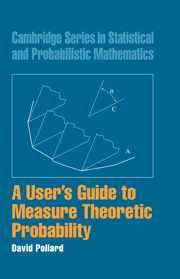Book contents
- Frontmatter
- Contents
- PREFACE
- CHAPTER 1 MOTIVATION
- CHAPTER 2 A MODICUM OF MEASURE THEORY
- CHAPTER 3 DENSITIES AND DERIVATIVES
- CHAPTER 4 PRODUCT SPACES AND INDEPENDENCE
- CHAPTER 5 CONDITIONING
- CHAPTER 6 MARTINGALE ET AL.
- CHAPTER 7 CONVERGENCE IN DISTRIBUTION
- CHAPTER 8 FOURIER TRANSFORMS
- CHAPTER 9 BROWNIAN MOTION
- CHAPTER 10 REPRESENTATIONS AND COUPLINGS
- CHAPTER 11 EXPONENTIAL TAILS AND THE LAW OF THE ITERATED LOGARITHM
- CHAPTER 12 MULTIVARIATE NORMAL DISTRIBUTIONS
- APPENDIX A MEASURES AND INTEGRALS
- APPENDIX B HILBERT SPACES
- APPENDIX C CONVEXITY
- APPENDIX D BINOMIAL AND NORMAL DISTRIBUTIONS
- APPENDIX E MARTINGALES IN CONTINUOUS TIME
- APPENDIX F DISINTEGRATION OF MEASURES
- INDEX
CHAPTER 9 - BROWNIAN MOTION
Published online by Cambridge University Press: 29 March 2011
- Frontmatter
- Contents
- PREFACE
- CHAPTER 1 MOTIVATION
- CHAPTER 2 A MODICUM OF MEASURE THEORY
- CHAPTER 3 DENSITIES AND DERIVATIVES
- CHAPTER 4 PRODUCT SPACES AND INDEPENDENCE
- CHAPTER 5 CONDITIONING
- CHAPTER 6 MARTINGALE ET AL.
- CHAPTER 7 CONVERGENCE IN DISTRIBUTION
- CHAPTER 8 FOURIER TRANSFORMS
- CHAPTER 9 BROWNIAN MOTION
- CHAPTER 10 REPRESENTATIONS AND COUPLINGS
- CHAPTER 11 EXPONENTIAL TAILS AND THE LAW OF THE ITERATED LOGARITHM
- CHAPTER 12 MULTIVARIATE NORMAL DISTRIBUTIONS
- APPENDIX A MEASURES AND INTEGRALS
- APPENDIX B HILBERT SPACES
- APPENDIX C CONVEXITY
- APPENDIX D BINOMIAL AND NORMAL DISTRIBUTIONS
- APPENDIX E MARTINGALES IN CONTINUOUS TIME
- APPENDIX F DISINTEGRATION OF MEASURES
- INDEX
Summary
SECTION 1 collects together some facts about stochastic processes and the normal distribution, for easier reference.
SECTION 2 defines Brownian motion as a Gaussian process indexed by a subinterval T of the real line. Existence of Brownian motions with and without continuous sample paths is discussed. Wiener measure is defined.
SECTION 3 constructs a Brownian motion with continuous sample paths, using an orthogonal series expansion of square integrable functions.
SECTION *4 describes some of the finer properties—lack of differentiability, and a modulus of continuity—for Brownian motion sample paths.
SECTION 5 establishes the strong Markov property for Brownian motion. Roughly speaking, the process starts afresh as a new Brownian motion after stopping times.
SECTION *6 describes a family of martingales that can be built from a Brownian motion, then establishes Lévy's martingale characterization of Brownian motion with continuous sample paths.
SECTION *7 shows how square integrable functions of the whole Brownian motion path can be represented as limits of weighted sums of increments. The result is a thinly disguised version of a remarkable property of the isometric stochastic integral, which is mentioned briefly.
SECTION *8 explains how the result from Section 7 is the key to the determination of option prices in a popular model for changes in stock prices.
Prerequisites
Broadly speaking, Brownian motion is to stochastic process theory as the normal distribution is to the theory for real random variables.
- Type
- Chapter
- Information
- A User's Guide to Measure Theoretic Probability , pp. 211 - 236Publisher: Cambridge University PressPrint publication year: 2001



